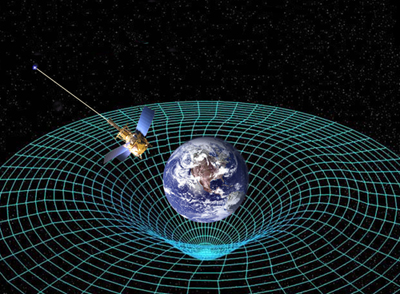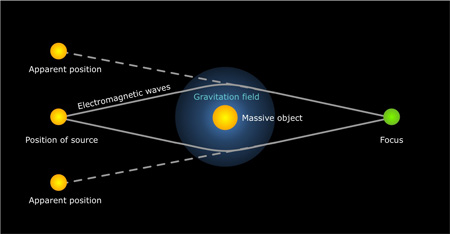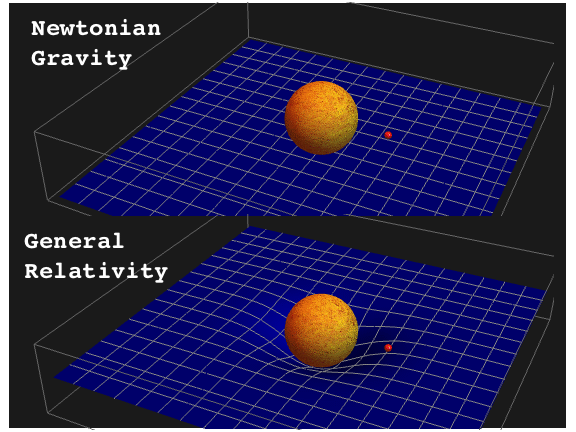
Our changing picture of gravity
When commander David Scott performed the last Moon walk of the Apollo 15 mission he took with him two objects you wouldn’t normally think to bring into space: in one hand he held a feather and in the other a hammer. When he let the two objects drop they fell towards the surface of the Moon — and landed at exactly the same time.
With this experiment Scott confirmed a rather counter-intuitive prediction Galileo Galilei had made nearly 400 years earlier: that gravity causes all objects to fall to the ground with the same acceleration, no matter how heavy they are. The reason we don’t usually see this effect on Earth is that air resistance interferes with the objects' fall. The Moon's atmosphere is much thinner than the Earth's, which is why Scott was able to demonstrate Galileo’s prediction.
Newton's theory of gravity
About a hundred years after Galilei's musings about gravity Isaac Newton revolutionised our understanding of it further, reportedly while he was sitting under an apple tree. Imagine a cannon on top of a very high mountain. If the cannon fired a cannonball, and there weren't a force of gravity (and no air resistance), then the cannonball would keep on travelling along a straight line, moving further and further away from Earth as the Earth's surface sloped away beneath it.
Since there is a force of gravity, however, the cannonball will eventually fall to the ground. How closely it falls to the mountain depends on the horizontal component of its velocity. The harder it is fired, the further away from the tree it'll hit the ground. Thus, so Newton mused, if you fire the cannonball with just the right amount of horizontal velocity, you can send it into orbit all the way around the Earth: gravity will make sure that it doesn't escape away from the Earth completely, and the horizontal component of its velocity will ensure that it doesn't hit the ground either. And an even higher horizontal component would send the cannonball would allow it to escape the Earth's vicinity all together.
This led Newton to realise that the force that draws a cannonball to the Earth and the force that keeps the Moon in its orbit around the Earth, or the planets in their orbits around the Sun, are one and the same thing. He thus came up with his universal law of gravitation, which states that any two objects exert a gravitational pull on each other, which is described in terms of their masses, their distance and the gravitational constant. Gravity, then, is a truly universal feature of the Universe and all objects inside it.
Einstein's general theory of relativity

Gravity is the manifestation of the curvature of space and time. Image courtesy NASA.
Newton's theory of gravity works very well in everyday situations and even in not-so-everyday situations: to fly to the Moon, for example, it is all the physics you need. When Albert Einstein started thinking about gravity, however, he encountered a problem. According to Newton, gravity is a force that acts instantaneously across long distances: if the Sun vanished in an instant, the Earth would feel the lack of gravity immediately. Einstein's special theory of relativity, however, asserts that nothing, not even a force such as gravity, should be able to travel faster than light. Newton's theory therefore couldn’t be quite right and Einstein started trying to modify it. (You can read more about Einstein's thought experiment here.)
The result of many years of hard work was, not just a tweaking of Newton's theory, but a completely new framework: Einstein's famous general theory of relativity (GR). He had taken inspiration from Galileo's insight that near Earth gravity affects all objects in the same way. If this was the case, then perhaps gravity was not a feature of the actual objects, but a feature of spacetime. General relativity asserts that massive objects like the Earth or Sun don’t emit a gravitational pull, but instead bend the very fabric of spacetime. This bending changes the way objects move as they travel through the curved spacetime: smaller objects are drawn towards massive objects, in some cases falling into orbit around them, or crashing into them.
Einstein revolutionised our understanding of gravity – but what were the repercussions of this new theory? What impact did it have on our understanding of the Universe?

Gravity bending light around a massive object. Image: DLR, GFDL.
Both Newton and Einstein's theories of gravity predict that light will be influenced by the gravity of massive objects like the Sun. In effect the path of light from distant stars is bent as the light passes near such massive objects, but the two theories predict that the light will be bent by different amounts. This difference in the theories offered one of the earliest chances to test Einstein's theory of general relativity, just a few years after he first discovered the theory. Two groups, led by the British astronomer Arthur Eddington, set out on two expeditions to observe the solar eclipse in 1919: one to the West coast of Africa, the other to Brazil. Their measurements of the position of the stars showed they had been shifted by the exact amounts predicts by Einstein's theory. (You can read more here.)

The orbit of Mercury as predicted by Newton's theory of gravity, and Einstein's general theory of relativity. (Animation by Michalis Agathos).
Einstein's theory also provided the answer to the mystery of Mercury's wayward path. Rather than orbit the Sun in a closed loop, Mercury winds around the Sun in a shape that is close to, but not quite the same as, an ellipse. Newton's theory failed to explain this anomalous behaviour, but Mercury's path was a direct consequence of Einstein's general theory of relativity.
And of course general relativity predicted many exotic and surprising phenomena that alarmed and excited the physics community – such as black holes and gravitational waves – phenomena that today we are finally observing for the first time.
About this article
This article is based on some lovely discussions with Ulrich Sperhake and Michalis Agathos. It also refers to some of our extensive coverage of gravity and Einstein's theory of general relativity. You can find out more in our collections of articles Celebrating general relativity, Mysterious black holes and about gravitational waves in Listening to the Universe.
Comments
Guest
Hello,
The sentence in the penultimate paragraph that reads,
"Newton's theory failed to explain this anamolous behaviour,"
spells 'anomalous' incorrectly.
No need to publish this comment, of course.
Thankyou for an exceptionally clear article. I particularly enjoyed the animations.
Marianne
Thanks for pointing this out, we have fixed the error.
Suresh Kumar
Excellent article on gravity.... Thanks a lot...
I have two things to point out from my opinion...
Exactly how gravity functions being depicted by scientists graphically generally is still not very convincing...
Secondly, why gravity is not powering any machine directly... I mean why we are not producing electricity from machines that are powered by gravity directly...
For example... Windmills are directly powered by wind... Water mill by water... Why there's no gravity mill around?....
Onoide Nsudo
The description of gravity put forward by science since from when it was construed portrays a picture of an invisible force lurking in the middle of matter to cause what elusively looks like an attractive force between matter. In my opinion, gravity is an optical illusion like mirage and rainbow. Gravity could be explained further from a different perspective.